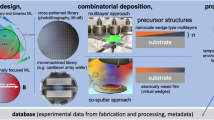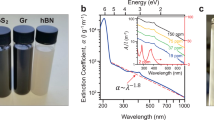Abstract
The desirable properties of atomically thin materials (ATMs) have encouraged development of preparation methods. However, many multi-element layered and non-layered ATMs are still difficult to be fabricated in a controlled manner. Here we design a flux-assisted growth approach to overcome these limitations that can reproducibly prepare high-quality ATMs, such as metal chalcogenides, oxides, oxyhalides and phosphorous trichalcogenides, and is tolerant to growth parameters such as temperature and flow rate. In this approach, target materials nucleate and crystallize following a flux-crystallization mechanism, enabling precise control of their stoichiometry. ATMs are guaranteed by the confined synthetic space and kinetically driven growth. Eighty atomically thin composite flakes, including 48 ternary or quaternary compounds and 23 non-layered materials, have been successfully prepared by this approach. Furthermore, large single crystals or continuous films of ATMs can be prepared by the same method. This proposed flux-crystallization mechanism offers great possibilities to fabricate ATMs with good stoichiometry control and non-layered structures that possess interesting physical and chemical properties.

This is a preview of subscription content, access via your institution
Access options
Subscribe to this journal
Receive 12 digital issues and online access to articles
$119.00 per year
only $9.92 per issue
Buy this article
- Purchase on Springer Link
- Instant access to full article PDF
Prices may be subject to local taxes which are calculated during checkout




Similar content being viewed by others
Data availability
The additional characterization data and experimental data are provided in the Supplementary Information and Supplementary Video. Source data are provided with this paper.
References
Bergeron, H. et al. Polymorphism in post-dichalcogenide two-dimensional materials. Chem. Rev. 121, 2713–2775 (2021).
Zhou, J. D. et al. A library of atomically thin metal chalcogenides. Nature 556, 355–359 (2018).
Li, J. et al. General synthesis of two-dimensional van der Waals heterostructure arrays. Nature 579, 368–374 (2020).
Nguyen, V. L. et al. Layer-controlled single-crystalline graphene film with stacking order via Cu–Si alloy formation. Nat. Nanotechnol. 15, 861–867 (2020).
Chen, T. A. et al. Wafer-scale single-crystal hexagonal boron nitride monolayers on Cu (111). Nature 579, 219–223 (2020).
Wang, L. et al. Epitaxial growth of a 100-square-centimetre singlecrystal hexagonal boron nitride monolayer on copper. Nature 570, 91–95 (2019).
Zhao, Y. Z. et al. Supertwisted spirals of layered materials enabled by growth on non-Euclidean surfaces. Science 370, 442–445 (2020).
Hong, Y. L. et al. Chemical vapor deposition of layered two-dimensional MoSi2N4 materials. Science 369, 670–674 (2020).
Shivayogimath, A. et al. A universal approach for the synthesis of two-dimensional binary compounds. Nat. Commun. 10, 2957 (2019).
Gong, Y. J. et al. Vertical and in-plane heterostructures from WS2/MoS2 monolayers. Nat. Mater. 13, 1135–1142 (2014).
Zhou, J. D. et al. Composition and phase engineering of metal chalcogenides and phosphorous chalcogenides. Nat. Mater. https://doi.org/10.1038/s41563-022-01291-5 (2022).
Xie, S. et al. Coherent, atomically thin transition-metal dichalcogenide superlattices with engineered strain. Science 359, 1131–1136 (2018).
Liu, F. et al. Disassembling 2D van der Waals crystals into macroscopic monolayers and reassembling into artificial lattices. Science 367, 903–906 (2020).
Huang, Y. et al. Universal mechanical exfoliation of large-area 2D crystals. Nat. Commun. 11, 2453 (2020).
Novoselov, K. S. et al. Two-dimensional atomic crystals. Proc. Natl Acad. Sci. USA 102, 10451–10453 (2005).
Gong, Y. J. et al. Spatially controlled doping of two-dimensional SnS2 through intercalation for electronics. Nat. Nanotechnol. 13, 294–299 (2018).
Lei, S. D. et al. Surface functionalization of two-dimensional metal chalcogenides by Lewis acid-base chemistry. Nat. Nanotechnol. 11, 465–471 (2016).
Ma, W. L. et al. In-plane anisotropic and ultra-low-loss polaritons in a natural van der Waals crystal. Nature 562, 557–562 (2018).
Hu, G. W. et al. Topological polaritons and photonic magic angles in twisted α-MoO3 bilayers. Nature 582, 209–213 (2020).
Liu, Y. et al. Approaching the Schottky–Mott limit in van der Waals metal semiconductor junctions. Nature 557, 696–700 (2018).
Wu, J. X. et al. High electron mobility and quantum oscillations in non-encapsulated ultrathin semiconducting Bi2O2Se. Nat. Nanotechnol. 12, 530–534 (2017).
Manzeli, S. et al. Self-sensing, tunable monolayer MoS2 nanoelectromechanical resonators. Nat. Commun. 10, 4831 (2019).
Chen, X. et al. CVD-grown monolayer MoS2 in bioabsorbable electronics and biosensors. Nat. Commun. 9, 1690 (2018).
Cao, Y. et al. Unconventional superconductivity in magic-angle graphene superlattices. Nature 556, 43–50 (2018).
Gong, C. & Zhang, X. Two-dimensional magnetic crystals and emergent heterostructure devices. Science 363, eaav4450 (2019).
Gu, Y., Zhang, S. Q. & Zou, X. L. Tunable magnetism in layered CoPS3 by pressure and carrier doping. Sci. China Mater. 64, 673–682 (2021).
Deng, Y. J. et al. Gate-tunable room-temperature ferromagnetism in two-dimensional Fe3GeTe2. Nature 563, 94–99 (2018).
May, A. F. et al. Ferromagnetism near room temperature in the cleavable van der Waals crystal Fe5GeTe2. ACS Nano 13, 4436–4442 (2019).
Zhang, F. et al. Carbon doping of WS2 monolayers: bandgap reduction and p-type doping transport. Sci. Adv. 5, eaav5003 (2019).
Li, N. et al. Large-scale flexible and transparent electronics based on monolayer molybdenum disulfide field-effect transistors. Nat. Electron. 3, 711–717 (2020).
Zhao, X. Y. et al. Engineering covalently bonded 2D layered materials by self-intercalation. Nature 581, 171–177 (2020).
Jin, S. et al. Colossal grain growth yields single-crystal metal foils by contact-free annealing. Science 362, 1021–1025 (2018).
Niu, L. et al. Controlled synthesis and room-temperature pyroelectricity of CuInP2S6 ultrathin flakes. Nano Energy 58, 596–603 (2019).
Chittari, B. L. et al. Electronic and magnetic properties of single-layer MPX3 metal phosphorous trichalcogenides. Phys. Rev. B 94, 184428 (2016).
Liu, Y. et al. Anomalous Hall effect in the weak-itinerant ferrimagnet FeCr2Te4. Phys. Rev. B 103, 045106 (2021).
Lei, S. M. et al. High mobility in a van der Waals layered antiferromagnetic metal. Sci. Adv. 6, eaay6407 (2020).
Peng, B. et al. Phase transition enhanced superior elasticity in freestanding single crystalline multiferroic BiFeO3 membranes. Sci. Adv. 6, eaba5847 (2020).
Zhou, C. S. et al. Magnetic and thermodynamic properties of α, β, γ and δ-MnO2. New J. Chem. 42, 8400–8407 (2018).
Li, H. D. et al. Two-dimensional metal telluride atomic crystals: preparation, physical properties, and applications. Adv. Funct. Mater. 31, 2010901 (2021).
Zhou, S. S. et al. Ultrathin non-van der Waals magnetic rhombohedral Cr2S3: space-confined chemical vapor deposition synthesis and Raman scattering investigation. Adv. Funct. Mater. 29, 1805880 (2019).
Barin, I. Thermochemical Data of Pure Substances 3rd edn (VCH, 1995).
Benz, K. W. et al. Growth of cadmium telluride from the vapor phase under low gravity conditions. Prog. Cryst. Growth Charact. Mater. 48/49, 189–208 (2004).
Li, T. T. et al. Epitaxial growth of wafer-scale molybdenum disulfide semiconductor single crystals on sapphire. Nat. Nanotechnol. 16, 1201–1207 (2021).
Wang, J. H. et al. Dual-coupling-guided epitaxial growth of wafer-scale single-crystal WS2 monolayer on vicinal α-plane sapphire. Nat. Nanotechnol. 17, 33–38 (2022).
Acknowledgements
This work was supported by the National Key R&D Program of China (grant number 2018YFA0306900), the Natural Science Foundation of China (22171016, 51872012, 21821004, 21932001) and the Beijing Outstanding Young Scientist Program (BJJWZYJH01201914430039). Part of calculations were supported by the high-performance computing (HPC) resources at Beihang University.
Author information
Authors and Affiliations
Contributions
Y.G., K.W. and P.Z. conceived and designed the experiments. P.Z., X.W., H.J. and Y.Z. synthesized the materials. X.W., H.J., Q.H. and H.Q. prepared the reaction powders by chemical vapour transport. P.Z., Q.H., X.W., H.J. and F.Z. performed the HRTEM characterizations of all samples, P.Z., X.W., H.J., Y.Z. and W.Z. worked on the analysis of HRTEM results. P.Z. and X.W. performed the AFM characterization of the samples. P.Z., B.L. and Y.Z. carried out Raman characterizations. K.S. performed device fabrication and measurement. A.C. and Z.H. carried out the PFM measurements. P.Z., X.W., H.J., K.W. and Y.G. wrote the paper with inputs from F.Z., Y.W., L.L., K.S. P.T. and W.Z. All authors participated in discussions and approved the manuscript.
Corresponding authors
Ethics declarations
Competing interests
The authors declare no competing interests.
Peer review
Peer review information
Nature Synthesis thanks Lei Liu, Youngdong Yoo and the other, anonymous, reviewer(s) for their contribution to the peer review of this work. Alexandra Groves, in collaboration with the Nature Synthesis team.
Additional information
Publisher’s note Springer Nature remains neutral with regard to jurisdictional claims in published maps and institutional affiliations.
Supplementary information
Supplementary Information
Supplementary Figs. 1–155, Discussion and Tables 1–4.
Supplementary Video 1
In situ growth observation of Fe3GeTe2.
Supplementary Video 2
In situ growth observation of CoTe2.
Supplementary Video 3
In situ growth observation of NiTe2.
Source data
Source Data Fig. 1
Data used to generate histogram graphs.
Source Data Fig. 3
Data used to generate energy-dispersive spectroscopy curves.
Source Data Fig. 4
Data used to generate graphs.
Rights and permissions
Springer Nature or its licensor holds exclusive rights to this article under a publishing agreement with the author(s) or other rightsholder(s); author self-archiving of the accepted manuscript version of this article is solely governed by the terms of such publishing agreement and applicable law.
About this article
Cite this article
Zhang, P., Wang, X., Jiang, H. et al. Flux-assisted growth of atomically thin materials. Nat. Synth 1, 864–872 (2022). https://doi.org/10.1038/s44160-022-00165-7
Received:
Accepted:
Published:
Issue Date:
DOI: https://doi.org/10.1038/s44160-022-00165-7
This article is cited by
-
Salt-assisted vapor–liquid–solid growth of high-quality ultrathin nickel oxide flakes for artificial synapses in image recognition applications
Nano Research (2024)
-
Surface-confined two-dimensional mass transport and crystal growth on monolayer materials
Nature Synthesis (2023)
-
The first year of Nature Synthesis
Nature Synthesis (2023)
-
Confined fluxes mediate 2D growth
Nature Synthesis (2022)



